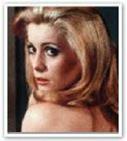There is a misconception that makeup done for television has to be heavy. That is not the case. The bright lights of television studios can wash out makeup colors, but don’t overcompensate with too heavy a hand. Use the same products you would use for day. Just make sure they are pumped up a notch, and perfectly blended.
Brighten the under-eye area by layering pink-toned corrector under yellow-toned concealer. Then set it with loose powder applied with a powder brush or puff. This step is an absolute necessity as television lights increase shine.
Use full-coverage foundation followed by powder to keep it matte. Sheer tints are too subtle for television.
Even if a glow is desired, it needs to be added to the cheeks at the end of the makeup application.
Color tends to wash out, so always use two shades of blush—one natural shade followed by a brighter pop of color. Correct blending is a must.
Avoid lip colors that are too light unless the subject’s lips are so full that you want to downplay them Television tends to wash out natural tones.
Define lips with pencil.
Make sure hands, arms, neck, and ears all match the face.
Bronzer is a great help, especially on the neck.
High-definition television is extremely unforgiving. (It definitely wasn’t invented by a woman over twenty years old.) It conveys very sharp contrast with great detail. The makeup you apply has to be both fluid and perfectly blended. Foundation that is not correctly applied will look like it’s melting off the face. Remember two words: coverage and blending.
Always check makeup in the monitor to see how it reads with lighting.
Blemishes need to be expertly covered.
Directors, lighting, and scripts dictate what style of makeup needs to be done. Communicate with everyone involved, ask lots of questions, and do lots of testing. The real makeup challenge, when working on films, is maintaining continuity. Scenes are often shot out of sequence, and part of a makeup artist’s job is to make sure the character looks the same in each scene. It can be a slow process, so always have a digital camera and a notebook handy to keep track of the shots. Lighting and style dictate what the makeup should look like.
These women are all icons and their looks have inspired many makeup artists to recreate them either in movies or editorial work. Whether it’s a direct period piece or just an element — these are the looks that inspire editors and photographers.
|
|
Light foundation and blush, extra pale lips, and classic medium-thick
eyeliner.
|
|
Her look was all about the strong squared-off brow, a matte powdery face,
and natural colors.
|
|
Sexy kitten, smoky eyes, and medium lips.
|
|
The icon of the natural American look. Brown eyeshadow, simple dark
brown liner, naturally strong brow, clean skin, tawny cheek, and nude lip.
|
|
Classic Italian, sexy yet understated. Her strong features don’t need a lot.
Strong brows, medium lips, clean black eyeliner, and a little blush.
|
|
Her makeup was all about a sexy face. Strong brows, white eyelids, smoky
contour, false eyelashes, and strong eyeliner, often with a red lip – classic
50s.
|
|
40s glamour – burgundy lips, eyes lined on top, shadow artfully applied,
strong brow, and visible black false eyelashes.
|
|
Whether playing the title role in Cleopatra or Martha in Who’s Afraid of
Virginia Woolf, she always had her violet eyes rimmed with black shadow,
eyeliner, and lashes.
|
|
A Hollywood princess: classic blonde and “Ralph Laurenesque” at a black-
tie ball.









